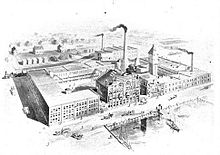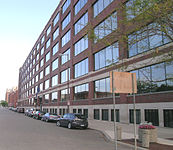
The Renaissance Center is a complex of seven connected skyscrapers in downtown Detroit, Michigan, United States. The Renaissance Center complex is on the Detroit International Riverfront and is owned and used by General Motors as its world headquarters. The central tower has been the tallest building in Michigan since its completion in 1977.

Parke-Davis is a subsidiary of the pharmaceutical company Pfizer. Although Parke, Davis & Co. is no longer an independent corporation, it was once America's oldest and largest drug maker, and played an important role in medical history. In 1970 Parke-Davis was acquired by Warner–Lambert, which in turn was acquired by Pfizer in 2000.

Downtown Louisville is the largest central business district in the Commonwealth of Kentucky and the urban hub of the Louisville, Kentucky Metropolitan Area. Its boundaries are the Ohio River to the north, Hancock Street to the east, York and Jacob Streets to the south, and 9th Street to the west. As of 2015, the population of downtown Louisville was 4,700, although this does not include directly surrounding areas such as Old Louisville, Butchertown, NuLu, and Phoenix Hill.
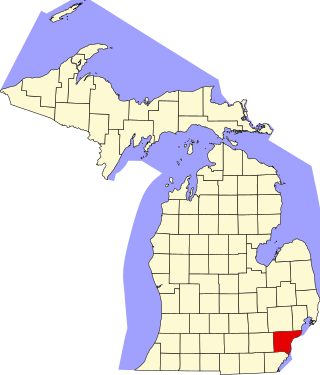
This is a list of the National Register of Historic Places listings in Wayne County, Michigan.

Downtown Tampa is the central business district of Tampa, Florida, United States, and the chief financial district of the Tampa Bay Area.

The architecture of metropolitan Detroit continues to attract the attention of architects and preservationists alike. With one of the world's recognizable skylines, Detroit's waterfront panorama shows a variety of architectural styles. The post-modern neogothic spires of One Detroit Center refer to designs of the city's historic Art Deco skyscrapers. Together with the Renaissance Center, they form the city's distinctive skyline.
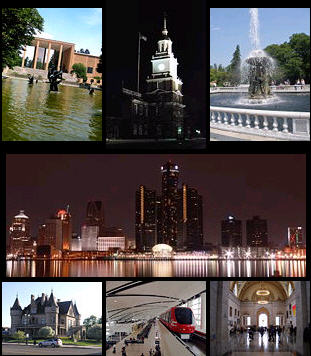
Tourism in metropolitan Detroit, Michigan is a significant factor for the region's culture and for its economy, comprising nine percent of the area's two million jobs. About 19 million people visit Metro Detroit spending an estimated 6 billion in 2019. In 2009, this number was about 15.9 million people, spending an estimated $4.8 billion. Detroit is one of the largest American cities and metropolitan regions to offer casino resort hotels. Leading multi-day events throughout Metro Detroit draw crowds of hundreds of thousands to over three million people. More than fifteen million people cross the highly traveled nexus of the Ambassador Bridge and the Detroit-Windsor Tunnel annually. Detroit is at the center of an emerging Great Lakes Megalopolis. An estimated 46 million people live within a 300-mile (480 km) radius of Metro Detroit.

The Detroit International Riverfront is a tourist attraction and landmark of Detroit, Michigan, extending from the Ambassador Bridge in the west to Belle Isle in the east, for a total of 5.5 miles. The International Riverfront encompasses a cruise ship passenger terminal and dock, a marina, a multitude of parks, restaurants, retail shops, skyscrapers, and high rise residential areas along with Huntington Place. The Marriott at the Renaissance Center and the Robert's Riverwalk Hotel are also situated along the International Riverfront. Private companies and foundations together with the city, state, and federal government have contributed several hundred million dollars toward the riverfront development. Key public spaces in the International Riverfront, such as the RiverWalk, Dequindre Cut Greenway and Trail, William G. Milliken State Park and Harbor, and a cruise ship passenger terminal and dock at Hart Plaza complement the architecture of the area. The area provides a venue for a variety of annual events and festivals including the Detroit Electronic Music Festival, Detroit Free Press International Marathon, the Detroit International Jazz Festival, Motor City Pride, the North American International Auto Show, River Days and Detroit China Festival. In February 2021, the Detroit International Riverfront was voted best riverwalk in the United States by USA Today readers. It was selected a second time as the best riverwalk in the U.S. in 2022.
Planning and development in Detroit since the late 20th century has attempted to enhance the economy and quality of life of Detroit, Michigan, United States. In 1970, the private group Detroit Renaissance began to facilitate development in the city. Its successor, Business Leaders for Michigan, has continued to facilitate development into the 21st century. Projects have included new commercial facilities, revitalization of neighborhoods, hospitality infrastructure, and improvements to recreational and public facilities, such as the QLine light rail project.

The Detroit Industry Murals (1932–1933) are a series of frescoes by the Mexican artist Diego Rivera, consisting of twenty-seven panels depicting industry at the Ford Motor Company and in Detroit. Together they surround the interior Rivera Court in the Detroit Institute of Arts. Painted between 1932 and 1933, they were considered by Rivera to be his most successful work. On April 23, 2014, the Detroit Industry Murals were designated by the Department of Interior as a National Historic Landmark.

The Roberts Riverwalk Urban Resort Hotel, formerly the Parke-Davis Research Laboratory also once known as Building 55-Detroit Research, is a luxury hotel on the Detroit International Riverfront in Detroit, Michigan. The former research facility was redeveloped as a boutique luxury hotel in the 1980s. The building was designated a National Historic Landmark in 1976 for its historic significance as an early research laboratory.

This is a list of the National Register of Historic Places listings in Detroit, Michigan.

The Antietam Avenue Bridge was located where Antietam Avenue passed over the Dequindre Cut in Detroit, Michigan. It has been demolished due to structural deficiencies and will be reconstructed. The original bridge was listed on the National Register of Historic Places in 2000.
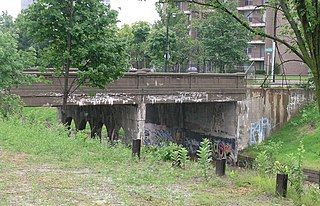
The Chestnut Street Bridge is located where Chestnut Street passes over the Dequindre Cut in Detroit, Michigan. It was listed on the National Register of Historic Places in 2000.

The East Jefferson Avenue Residential District in Detroit, Michigan, includes the Thematic Resource (TR) in the multiple property submission to the National Register of Historic Places which was approved on October 9, 1985. The structures are single-family and multiple-unit residential buildings with construction dates spanning nearly a century, from 1835 to 1931. The area is located on the lower east side of the city.

The Dequindre Cut is a below-grade pathway, formerly a Grand Trunk Western Railroad line, located on the east side of Detroit, Michigan, just west of St. Aubin Street. Much of the Cut has been converted to a greenway; the colorful graffiti along the pathway has been left in place.

This is a list of the National Register of Historic Places listings in Downtown and Midtown Detroit, Michigan. It is intended to be a complete list of the properties and districts on the National Register of Historic Places in Downtown and Midtown neighborhoods in Detroit, Michigan, United States. Latitude and longitude coordinates are provided for many National Register properties and districts; these locations may be seen together in online maps.

The Joseph Campau Historic District is a commercial historic district located along Joseph Campau Street in Hamtramck, Michigan. The district runs from roughly Holbrook and Lehman Streets on the south to Pulaski and Casmere Streets on the north. It was listed on the National Register of Historic Places in 2012.

Joseph Campau Street, also known as Joseph Campau Avenue, is a city street in Hamtramck and Detroit in the southeastern part of the U.S. state of Michigan. Jos. Campau Historic District is located along the street in Hamtramck. Along Joseph Campau Street and the Detroit River are River Place and The Roberts Riverwalk Hotel and Residence Detroit.


